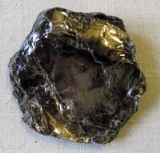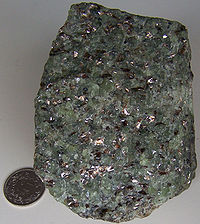
Phlogopite
Encyclopedia
Phlogopite is a yellow, greenish, or reddish-brown member of the mica
family of phyllosilicates
. It is also known as magnesium
mica.
Phlogopite is the magnesium endmember of the biotite
solid solution
series, with the chemical formula KMg3AlSi3O10(F,OH)2. Iron substitutes for magnesium in variable amounts leading to the more common biotite
with higher iron content. For physical and optical identification, it shares most of the characteristic properties of biotite.
aureoles of intrusive
igneous rock
s with magnesian country rocks.
The occurrence of phlogopite mica within igneous rocks is difficult to constrain precisely because the primary control is rock composition as expected, but phlogopite is also controlled by conditions of crystallisation such as temperature, pressure, and vapor content of the igneous rock. Several igneous associations are noted: high-alumina basalt
s, ultrapotassic igneous rocks, and ultramafic rocks.
s and high-alumina basalts. Phlogopite is stable in basaltic compositions at high pressures and is often present as partially-resorbed phenocryst
s or an accessory phase in basalts generated at depth.
, kimberlite
, lamproite
, and other deeply-sourced ultramafic or high-magnesian melts. In this association phlogopite can form well preserved megacrystic plates to 10 cm, and is present as the primary groundmass mineral, or in association with pargasite amphibole, olivine, and pyroxene. Phlogopite in this association is a primary igneous mineral present because of the depth of melting and high vapor pressures.

has resulted in phlogopite formation within large volumes, as in the ultramafic massif at Finero, Italy, within the Ivrea zone
. Trace phlogopite, again considered the result of metasomatism, is common within coarse-grained peridotite
xenolith
s carried up by kimberlite
, and so phlogopite appears to be a common trace mineral in the uppermost part of the Earth's mantle. Phlogopite is encountered as a primary igneous phenocryst
within lamproite
s and lamprophyres, the result of highly fluid-rich melt compositions within the deep mantle.
, Canada
; it measured 10x4.3x4.3 m3 and weighed about 330 metric tons. Similar-sized crystals were also found in Karelia
, Russia
.
Mica
The mica group of sheet silicate minerals includes several closely related materials having highly perfect basal cleavage. All are monoclinic, with a tendency towards pseudohexagonal crystals, and are similar in chemical composition...
family of phyllosilicates
Silicate minerals
The silicate minerals make up the largest and most important class of rock-forming minerals, constituting approximately 90 percent of the crust of the Earth. They are classified based on the structure of their silicate group...
. It is also known as magnesium
Magnesium
Magnesium is a chemical element with the symbol Mg, atomic number 12, and common oxidation number +2. It is an alkaline earth metal and the eighth most abundant element in the Earth's crust and ninth in the known universe as a whole...
mica.
Phlogopite is the magnesium endmember of the biotite
Biotite
Biotite is a common phyllosilicate mineral within the mica group, with the approximate chemical formula . More generally, it refers to the dark mica series, primarily a solid-solution series between the iron-endmember annite, and the magnesium-endmember phlogopite; more aluminous endmembers...
solid solution
Solid solution
A solid solution is a solid-state solution of one or more solutes in a solvent. Such a mixture is considered a solution rather than a compound when the crystal structure of the solvent remains unchanged by addition of the solutes, and when the mixture remains in a single homogeneous phase...
series, with the chemical formula KMg3AlSi3O10(F,OH)2. Iron substitutes for magnesium in variable amounts leading to the more common biotite
Biotite
Biotite is a common phyllosilicate mineral within the mica group, with the approximate chemical formula . More generally, it refers to the dark mica series, primarily a solid-solution series between the iron-endmember annite, and the magnesium-endmember phlogopite; more aluminous endmembers...
with higher iron content. For physical and optical identification, it shares most of the characteristic properties of biotite.
Paragenesis
Phlogopite is an important and relatively common end-member composition of biotite. Phlogopite micas are found primarily in igneous rocks, although it is also common in contact metamorphicMetamorphic rock
Metamorphic rock is the transformation of an existing rock type, the protolith, in a process called metamorphism, which means "change in form". The protolith is subjected to heat and pressure causing profound physical and/or chemical change...
aureoles of intrusive
Intrusion
An intrusion is liquid rock that forms under Earth's surface. Magma from under the surface is slowly pushed up from deep within the earth into any cracks or spaces it can find, sometimes pushing existing country rock out of the way, a process that can take millions of years. As the rock slowly...
igneous rock
Igneous rock
Igneous rock is one of the three main rock types, the others being sedimentary and metamorphic rock. Igneous rock is formed through the cooling and solidification of magma or lava...
s with magnesian country rocks.
The occurrence of phlogopite mica within igneous rocks is difficult to constrain precisely because the primary control is rock composition as expected, but phlogopite is also controlled by conditions of crystallisation such as temperature, pressure, and vapor content of the igneous rock. Several igneous associations are noted: high-alumina basalt
Basalt
Basalt is a common extrusive volcanic rock. It is usually grey to black and fine-grained due to rapid cooling of lava at the surface of a planet. It may be porphyritic containing larger crystals in a fine matrix, or vesicular, or frothy scoria. Unweathered basalt is black or grey...
s, ultrapotassic igneous rocks, and ultramafic rocks.
Basaltic association
The basaltic occurrence of phlogopite is in association with picrite basaltPicrite basalt
Picrite basalt, picrobasalt or oceanite is a variety of high-magnesium olivine basalt that is very rich in the mineral olivine. It is dark with yellow-green olivine phenocrysts and black to dark brown pyroxene, mostly augite....
s and high-alumina basalts. Phlogopite is stable in basaltic compositions at high pressures and is often present as partially-resorbed phenocryst
Phenocryst
thumb|right|300px|[[Granite]]s often have large [[feldspar|feldspatic]] phenocrysts. This granite, from the [[Switzerland|Swiss]] side of the [[Mont Blanc]] massif, has large white [[plagioclase]] phenocrysts, [[triclinic]] [[mineral]]s that give [[trapezium|trapezoid]] shapes when cut through)...
s or an accessory phase in basalts generated at depth.
Ultrapotassic association
Phlogopite mica is a commonly known phenocryst and groundmass phase within ultrapotassic igneous rocks such as lamprophyreLamprophyre
Lamprophyres are uncommon, small volume ultrapotassic igneous rocks primarily occurring as dikes, lopoliths, laccoliths, stocks and small intrusions...
, kimberlite
Kimberlite
Kimberlite is a type of potassic volcanic rock best known for sometimes containing diamonds. It is named after the town of Kimberley in South Africa, where the discovery of an diamond in 1871 spawned a diamond rush, eventually creating the Big Hole....
, lamproite
Lamproite
Lamproites are ultrapotassic mantle-derived volcanic and subvolcanic rocks. They have low CaO, Al2O3, Na2O, high K2O/Al2O3, a relatively high MgO content and extreme enrichment in incompatible elements....
, and other deeply-sourced ultramafic or high-magnesian melts. In this association phlogopite can form well preserved megacrystic plates to 10 cm, and is present as the primary groundmass mineral, or in association with pargasite amphibole, olivine, and pyroxene. Phlogopite in this association is a primary igneous mineral present because of the depth of melting and high vapor pressures.

Ultramafic rocks
Phlogopite is often found in association with ultramafic intrusions as a secondary alteration phase within metasomatic margins of large layered intrusions. In some cases the phlogopite is considered to be produced by autogenic alteration during cooling. In other instances, metasomatismMetasomatism
Metasomatism is the chemical alteration of a rock by hydrothermal and other fluids.Metasomatism can occur via the action of hydrothermal fluids from an igneous or metamorphic source. In the igneous environment, metasomatism creates skarns, greisen, and may affect hornfels in the contact...
has resulted in phlogopite formation within large volumes, as in the ultramafic massif at Finero, Italy, within the Ivrea zone
Ivrea zone
The Ivrea zone is a tectonic terrane in the Italian Alps, that consists of a steeply dipping piece of the Earth’s lower crust of the Apulian plate. The zone is named after the Italian city of Ivrea....
. Trace phlogopite, again considered the result of metasomatism, is common within coarse-grained peridotite
Peridotite
A peridotite is a dense, coarse-grained igneous rock, consisting mostly of the minerals olivine and pyroxene. Peridotite is ultramafic, as the rock contains less than 45% silica. It is high in magnesium, reflecting the high proportions of magnesium-rich olivine, with appreciable iron...
xenolith
Xenolith
A xenolith is a rock fragment which becomes enveloped in a larger rock during the latter's development and hardening. In geology, the term xenolith is almost exclusively used to describe inclusions in igneous rock during magma emplacement and eruption...
s carried up by kimberlite
Kimberlite
Kimberlite is a type of potassic volcanic rock best known for sometimes containing diamonds. It is named after the town of Kimberley in South Africa, where the discovery of an diamond in 1871 spawned a diamond rush, eventually creating the Big Hole....
, and so phlogopite appears to be a common trace mineral in the uppermost part of the Earth's mantle. Phlogopite is encountered as a primary igneous phenocryst
Phenocryst
thumb|right|300px|[[Granite]]s often have large [[feldspar|feldspatic]] phenocrysts. This granite, from the [[Switzerland|Swiss]] side of the [[Mont Blanc]] massif, has large white [[plagioclase]] phenocrysts, [[triclinic]] [[mineral]]s that give [[trapezium|trapezoid]] shapes when cut through)...
within lamproite
Lamproite
Lamproites are ultrapotassic mantle-derived volcanic and subvolcanic rocks. They have low CaO, Al2O3, Na2O, high K2O/Al2O3, a relatively high MgO content and extreme enrichment in incompatible elements....
s and lamprophyres, the result of highly fluid-rich melt compositions within the deep mantle.
Miscellaneous
The largest documented single crystal of phlogopite was found in Lacey mine, OntarioOntario
Ontario is a province of Canada, located in east-central Canada. It is Canada's most populous province and second largest in total area. It is home to the nation's most populous city, Toronto, and the nation's capital, Ottawa....
, Canada
Canada
Canada is a North American country consisting of ten provinces and three territories. Located in the northern part of the continent, it extends from the Atlantic Ocean in the east to the Pacific Ocean in the west, and northward into the Arctic Ocean...
; it measured 10x4.3x4.3 m3 and weighed about 330 metric tons. Similar-sized crystals were also found in Karelia
Karelia
Karelia , the land of the Karelian peoples, is an area in Northern Europe of historical significance for Finland, Russia, and Sweden...
, Russia
Russia
Russia or , officially known as both Russia and the Russian Federation , is a country in northern Eurasia. It is a federal semi-presidential republic, comprising 83 federal subjects...
.

